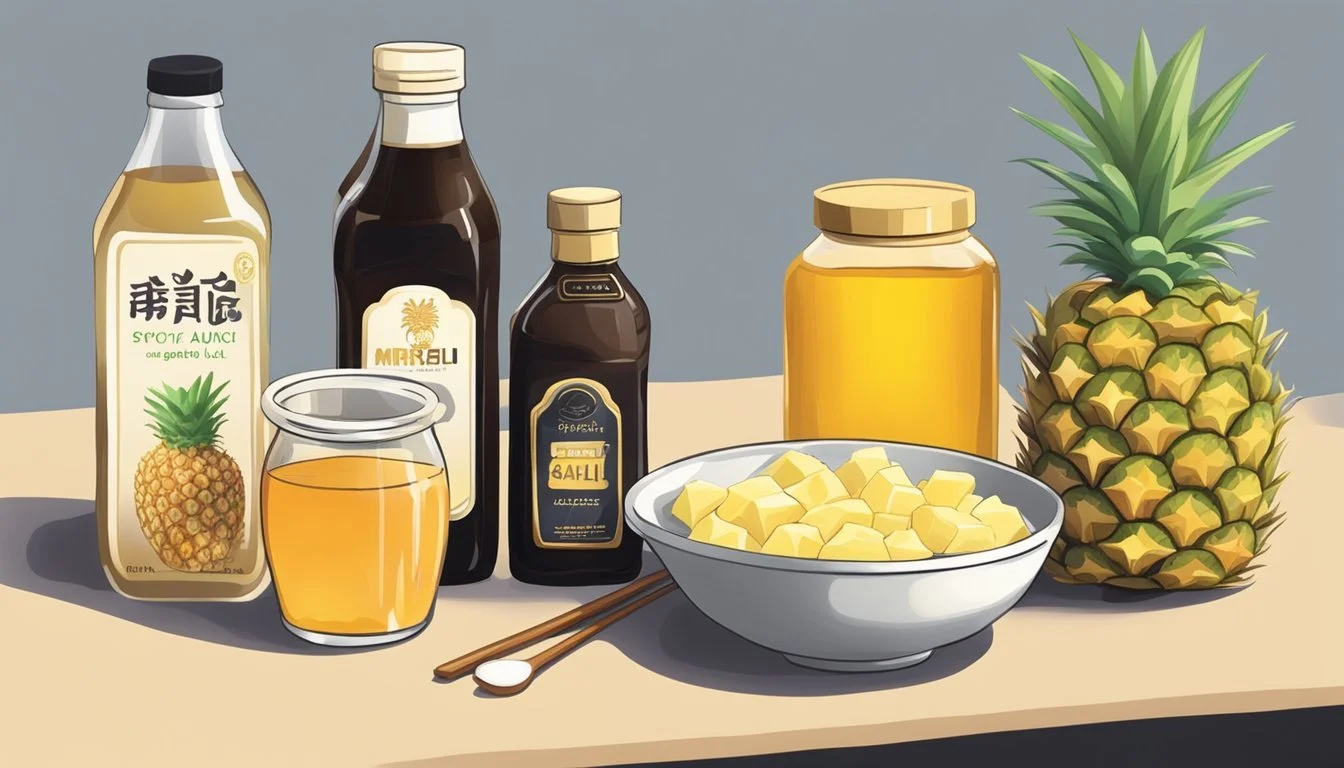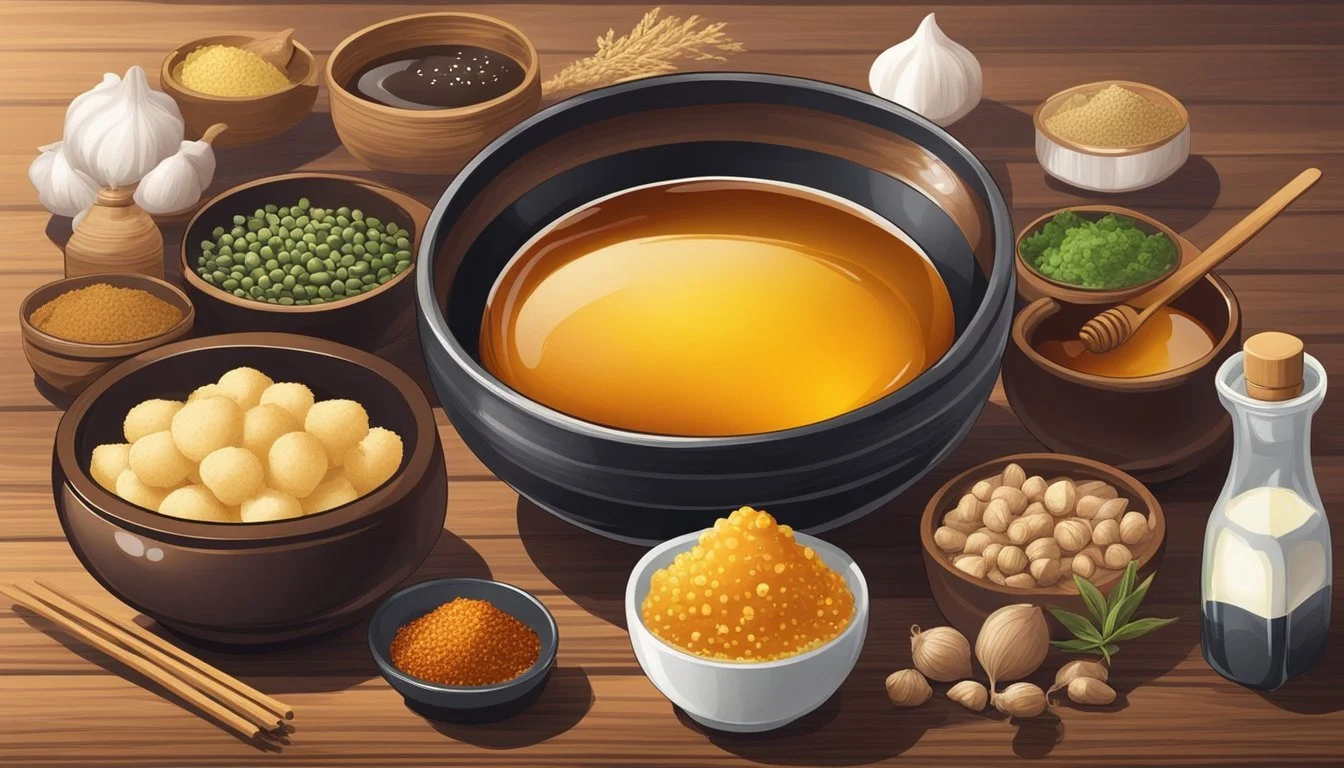Teriyaki Sauce Substitutes
Top Alternatives for Your Recipes
Teriyaki sauce is a staple in many kitchens, revered for its perfect balance of sweet, savory, and tangy flavors. Its versatility in cooking is unparalleled, often used as a marinade, glaze, or dipping sauce. The complexity it brings to dishes is attributed to its unique blend of ingredients, which typically includes soy sauce, a sweetener like sugar or honey, ginger, garlic, and sometimes mirin, a type of rice wine. These ingredients fuse to create a sauce that's rich and thick, ideal for enhancing the flavor profile of a wide range of dishes.
However, cooks may sometimes find themselves without this essential condiment or may seek alternatives due to dietary restrictions or taste preferences. Fortunately, there are numerous substitutes that can step in to provide similar umami qualities and a comparable depth of flavor. From pantry staples like soy sauce mixed with sweeteners, to other Asian-inspired sauces such as hoisin or Korean BBQ sauce, the range of alternatives is broad and accessible.
Understanding these substitutes not only ensures that a dish never goes without the unique touch that teriyaki sauce offers, but it also opens up new culinary possibilities. Whether seeking a lower-sugar option or simply experimenting with different ingredients, these alternatives provide both versatility and convenience to home cooks and chefs alike, ensuring that the essence of teriyaki sauce is never truly out of reach.
Understanding Teriyaki Sauce
Teriyaki sauce is an integral element in Japanese cuisine, known for its versatile role and distinctive taste. It’s a favorite for marinating, glazing, and as a condiment.
Origins and Uses
Teriyaki sauce originates from Japan and has gained international popularity. It's commonly used for marinating proteins like chicken, beef, and fish, giving them a savory and slightly sweet flavor ideal for grilling or stir-frying. Additionally, teriyaki sauce serves as a rich glaze for various dishes to enhance their flavor profile.
Key Ingredients
The base of traditional teriyaki sauce consists of:
Soy sauce: Provides the salty, umami foundation.
Sugar: Offers sweetness, balancing the savory notes.
Garlic: Adds a pungent depth.
Ginger: Imparts a warm, zesty kick.
These key ingredients come together to create teriyaki sauce's unique taste that complements and enriches the flavors of countless dishes within Japanese cuisine and beyond.
Fundamentals of Substituting Teriyaki Sauce
When substituting teriyaki sauce, one must carefully balance key flavor components such as sweetness, zing, salt, and umami to match the complex taste profile of traditional teriyaki sauce.
Taste Profile Considerations
The hallmark of teriyaki sauce is its unique combination of flavors. It possesses a sweetness typically derived from sugars like honey or brown sugar, a zing from ingredients such as ginger or garlic, saltiness from soy sauce, and the elusive umami that rounds out its distinctive taste. When seeking substitutes, one should aim for a blend that reflects these characteristics.
Sweetness: Essential to mimic the caramel-like quality of teriyaki. Honey, brown sugar, or other sweeteners can be used.
Zing: Fresh ginger or garlic boosts the sauce’s vibrancy and helps cut through the sweetness.
Salt: Soy sauce is often the salt component, providing the needed salinity.
Umami: This savory depth is often achieved with soy sauce or even Worcestershire sauce.
Common Ingredient Substitutes
In the absence of traditional teriyaki sauce, several ingredients can be combined to make an adequate substitute. The key is to balance the elements that comprise the teriyaki sauce's profile:
Substitute Component Suggestions Base (Umami and Salt) Soy sauce, tamari, or Worcestershire sauce Sweetener (Sweetness) Sugar, honey, maple syrup Acid (Zing) Rice vinegar, citrus juice Additional Flavor (Zing) Garlic, ginger
Homemade blend: Mixing soy sauce with a sweetener and a dash of vinegar or citrus juice can create a quick teriyaki-like flavor.
Pre-made substitutes: Hoisin sauce, Korean BBQ sauce, or a generic stir-fry sauce can provide a similar flavor profile, though they should be adjusted to ensure the right balance of sweet, zingy, and umami notes.
Homemade Teriyaki Sauce Substitutes
Creating a substitute for teriyaki sauce at home can be an easy and rewarding endeavor, particularly when the aim is to match personal taste preferences or dietary requirements. The key components typically include a balance of umami, sweetness, and a hint of acidity.
DIY Teriyaki Sauce Recipes
Basic Homemade Teriyaki:
Combine equal parts of soy sauce and mirin, and add half the amount of sugar.
Heat the mixture gently, stirring until the sugar dissolves.
For added flavor, include minced garlic or grated ginger.
Ingredient Amount Soy Sauce 1 part Mirin 1 part Sugar 0.5 parts Garlic (optional) To taste Ginger (optional) To taste
Alternative Sweetener: Replace sugar with honey for a natural sweetening option.
Thickening Agent:
Mix cornstarch with cold water to create a slurry.
Introduce to the sauce, heating until the desired thickness is achieved.
Healthy Alternatives
Sugar-Free Sweetness: Utilize a sugar substitute or enhance natural sweetness with extra honey to reduce refined sugars.
Lower Sodium: For those monitoring salt intake, opt for a low-sodium soy sauce.
Enhanced Flavor Without Extra Calories:
Use vinegar to add a tang without significant caloric addition.
Incorporate spices like garlic and ginger for depth of flavor not reliant on sugar or fats.
Commercial Sauce Alternatives
In the realm of commercial sauces, there are specific substitutes that can aptly mimic the flavor profile of teriyaki sauce. These readily available options offer convenience for those needing a quick alternative.
Best Store-Bought Options
For a comparable taste to traditional teriyaki sauce, one can consider a variety of store-bought products. Two notably similar sauces are:
Hoisin Sauce: A thick, fragrant sauce often used in Chinese cuisine, hoisin sauce provides a balance of sweet and savory that can substitute for teriyaki in many dishes.
Korean BBQ Sauce: This sauce, sometimes labeled as Korean teriyaki, can be used for glazing and basting with its balance of sweet, tangy, and savory flavors.
Should you favor an Indonesian flair:
Kecap Manis: A sweet soy sauce, kecap manis has the added depth of palm sugar, which makes it an excellent alternative to teriyaki for marinades and glazes.
For those who prefer a Western twist:
BBQ Sauce: While generally a bit tangier, when chosen carefully, some sweeter varieties of BBQ sauce can stand in for teriyaki in a pinch.
Gluten-Free and Vegetarian Choices
For individuals with dietary restrictions, there are sauces that sidestep common allergens while still delivering rich flavors:
Gluten-Free Soy Sauce Options: Several brands offer gluten-free soy sauces that can be sweetened with sugar or honey to fashion a teriyaki-like marinade.
Coconut Aminos: As a soy- and gluten-free teriyaki alternative, coconut aminos bring a similar sweet and salty balance and are suitable for both gluten-free and vegetarian diets.
Additionally, components like:
Oyster Sauce: While not suitable for vegetarians, oyster sauce can provide the savory depth you're after, provided you opt for a gluten-free brand if necessary.
Specific Recipe Adaptations
Teriyaki sauce is a versatile condiment commonly used in various dishes to add a sweet and savory flavor. When the original sauce is unavailable, knowing the right substitute for different food types ensures successful adaptation without compromising taste.
Meat and Poultry
For chicken and beef dishes that require a teriyaki glaze or marinade, a simple combination of soy sauce, sugar, and mirin or a mirin substitute such as white cooking wine or Shaoxing rice wine can be used. It's essential to cook this mixture until the sugar dissolves, creating a glaze similar in taste and consistency to teriyaki sauce.
For grilling: Use a mix of soy sauce, honey, or brown sugar, adjusting the sweetness to taste. Baste the meat frequently during the cooking process.
For stir-fries: Add the substitute sauce in the last minutes of cooking to coat the meat evenly without burning the sugars.
Seafood
When seasoning fish or other seafood, a lighter substitute is preferable to not overpower the delicate flavors.
Ponzu sauce, with its citrus undertones, makes an excellent teriyaki substitute for seafood dishes. It marries well with the natural flavors of seafood without being too heavy.
A mix of soy sauce with a smaller amount of sugar or honey can also work, creating a balanced umami flavor with a hint of sweetness, suitable for basting or marinating before cooking.
Vegetable Dishes
Vegetables can absorb flavors deeply, so the right substitute must compliment the produce without overwhelming it.
For vegetable stir-fries or glazes, consider using hoisin sauce or a Korean BBQ sauce. These sauces provide a rich flavor that's similar to teriyaki without altering the inherent taste of the vegetables.
Create a light sauce with soy sauce, a sweetener like honey or agave, and a splash of acid such as rice vinegar. This alternative provides a teriyaki-like experience while keeping the dish vibrant and fresh.
Sauce Preparation Techniques
When crafting a teriyaki sauce substitute, there are techniques to ensure the result mirrors the texture and flavor profile of traditional teriyaki sauce. Proper thickening methods, flavor balancing, and marinating essentials are crucial for an authentic-tasting substitute.
Thickening Methods
In the absence of natural reduction found in traditional teriyaki sauce, cornstarch and flour act as thickening agents. To use:
Cornstarch: Mix with equal parts cold water to create a slurry before adding to the sauce.
Flour: Cook flour briefly in a separate pan to create a roux before incorporating into the sauce for thickening.
Both methods prevent clumping and ensure a smooth texture, echoing the viscous consistency of teriyaki sauce.
Flavor Balancing
A proper teriyaki sauce substitute requires a delicate balance between sweetness, umami, and acidity. For this balance:
Sweeteners: Utilize honey, brown sugar, or a sweetener of choice mimicking the sweetness from mirin.
Umami: Soy sauce is essential, or one may use alternatives like tamari for gluten-free options.
Acidity: In lieu of sake, a dash of citrus juice or vinegar can provide the necessary tang.
One must carefully adjust these elements to emulate the complex flavor profile of authentic teriyaki sauce.
Marinating Essentials
A good substitute also serves as an effective marinade. Key considerations include:
Duration: Marinate proteins for at least 30 minutes to ensure deep flavor penetration.
Ingredients: A combination of soy sauce, sweetener, thickener, and sake or an acidic component preserves the teriyaki character.
Marinades using these substitutes not only impart flavor but also tenderize the proteins, as traditional teriyaki sauce would do.
Cultural Variations and Influences
When exploring teriyaki sauce substitutes, it's essential to consider the cultural foundations and adaptations that have influenced alternative ingredients and uses in cooking.
Japanese Cooking Traditions
In its traditional Japanese context, teriyaki sauce is a condiment that is often used to glaze fish, such as mackerel or salmon. The classic Japanese teriyaki sauce is a combination of soy sauce, mirin (a sweet rice wine), and sugar, which is reduced to a thick glaze. The simplicity of this sauce highlights the natural flavors of the ingredients it complements.
Chinese Influence
Chinese cuisine has introduced richer, more complex flavors to teriyaki through ingredients like hoisin sauce. This thick and flavorful sauce often contains soybeans, fennel seeds, red chilies, and garlic, imparting a more robust taste suitable for marinades and stir-fries. It can offer a substitute with additional depth, often embraced in fusion dishes that marry Chinese and Japanese flavors.
Korean and Indonesian Twists
Korean and Indonesian cuisines bring their own unique twists to teriyaki sauce with alternatives like korean barbecue sauce, which is often used for marinated dishes such as galbi. This typically includes ingredients like soy sauce, garlic, sugar, and sesame oil, providing a balance of sweet and savory similar to traditional teriyaki.
The Indonesian kecap manis is another substitute; it's a thicker, sweeter soy sauce, which is sometimes used in place of the more common teriyaki sauce. It adds a distinctive flavor, demonstrating a cross-cultural adoption that can be particularly noticeable in regional variations, such as the Hawaiian version, where influences from multiple cultures frequently integrate.
Pairing with Meals and Occasions
Identifying the right teriyaki sauce substitute can enhance various meals effectively and suit different occasions, whether it's a casual family dinner, a festive event, or day-to-day culinary adventures. Each context may call for a different blend of flavors, but numerous options can rise to the occasion.
Casual Dinners
For casual dinners, a relaxed atmosphere pairs well with comfort foods like teriyaki chicken or grilled meats. A simple substitute such as a mix of soy sauce and honey in equal parts offers the perfect balance of savory and sweet without overshadowing the main dish's flavors. Here's a quick guide for casual meal pairings:
Teriyaki Chicken: Homemade teriyaki sauce using soy sauce, a sweetener (like honey or brown sugar), and a touch of acid (like vinegar or lemon juice) can replicate the classic teriyaki flavor profile.
Grilled Meats: A bold hoisin sauce or Korean BBQ sauce can provide a more intense flavor for barbecuing, complementing the smokiness of the grill.
Special Events
For special events, one might seek bolder flavors to impress their guests. Here, more refined substitutes could include:
Oyster Sauce: While slightly more intense, it brings a depth of flavor that suits formal dishes.
Ponzu Sauce: This citrus-based sauce adds a unique flair that can elevate seafood-based rice dishes or even fried rice, making it an excellent choice for special occasion recipes.
Everyday Cooking
Within the realm of everyday cooking, efficiency meets passion. Cooking enthusiasts often resort to the use of versatile substitutes that are both easy to prepare and store.
For a quick teriyaki glaze, soy sauce combined with a sweetener and perhaps a dash of ginger powder can be a go-to option, readily available for a wide range of dishes.
A BBQ sauce, slightly modified with reduced sugar, can serve as a hassle-free stand-in for teriyaki sauce in many everyday recipes, providing a familiar yet varied taste profile.
By considering the specific meal and occasion, one can select an appropriate teriyaki sauce substitute that not only complements the dish but also the ambiance of the dining experience.







